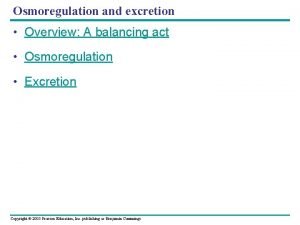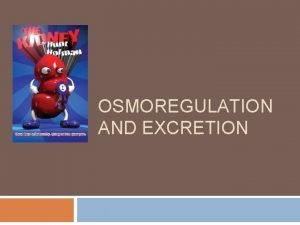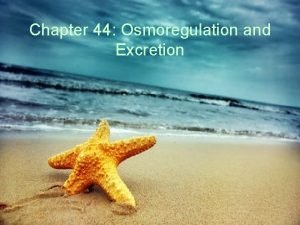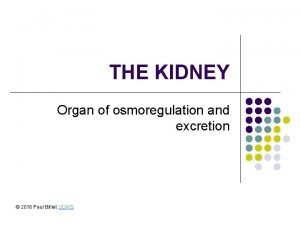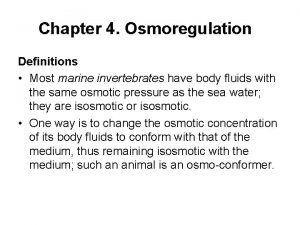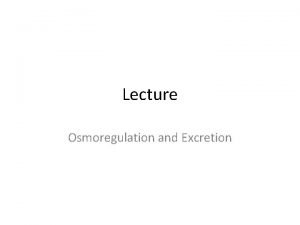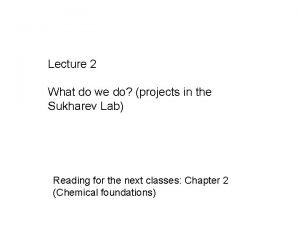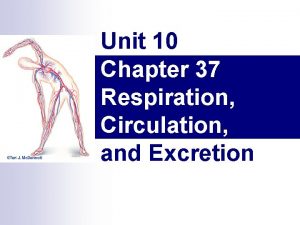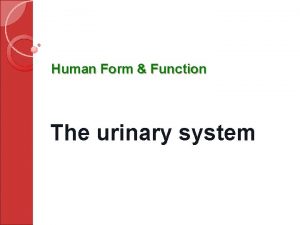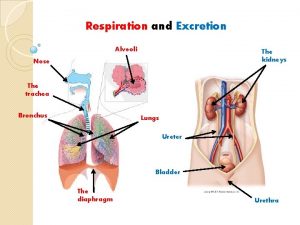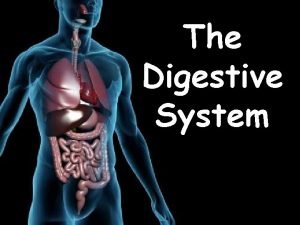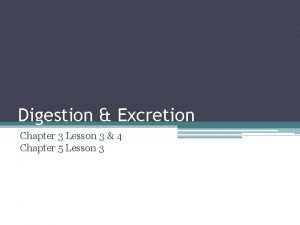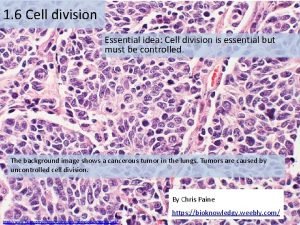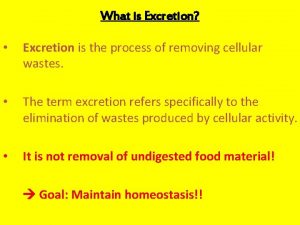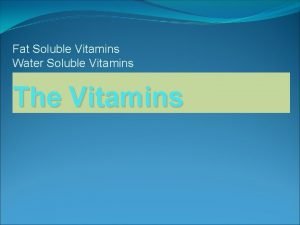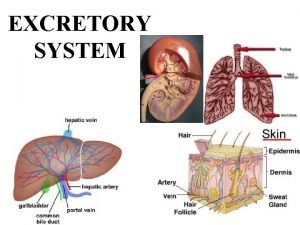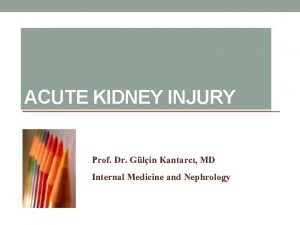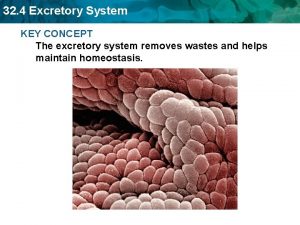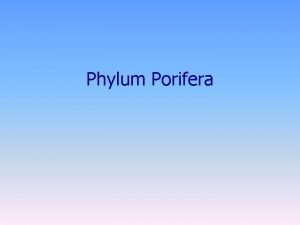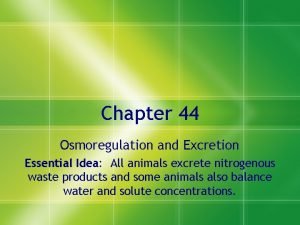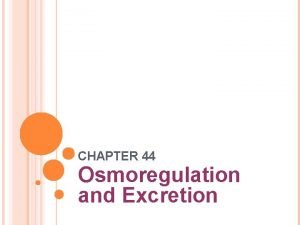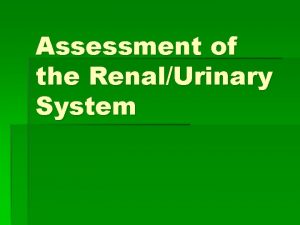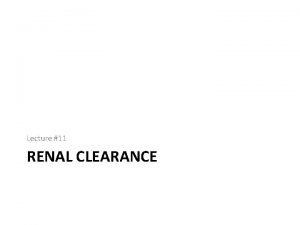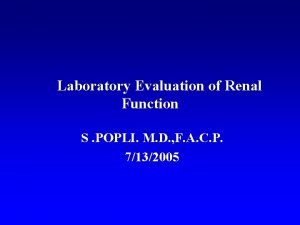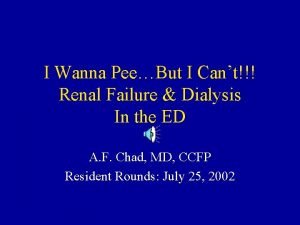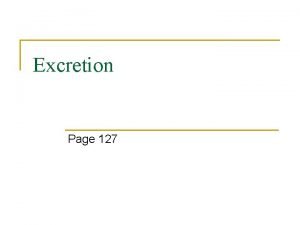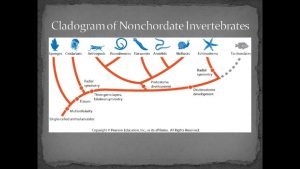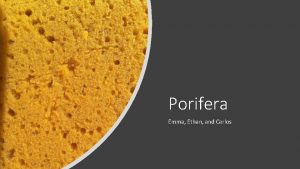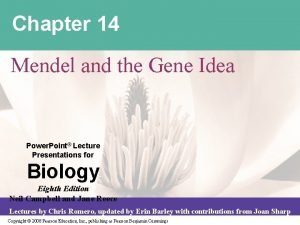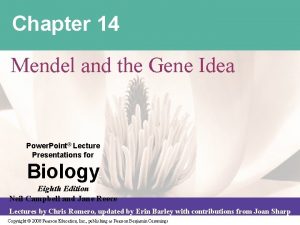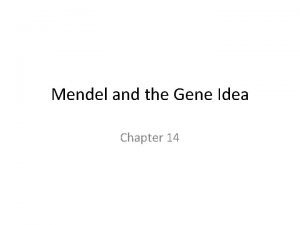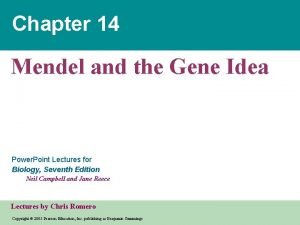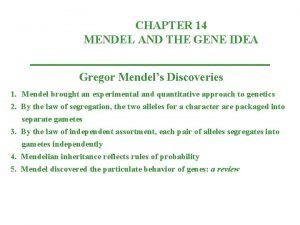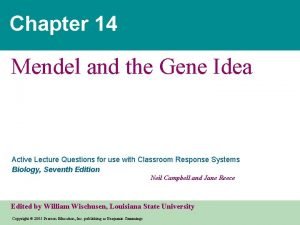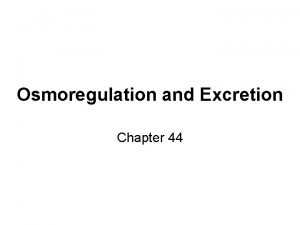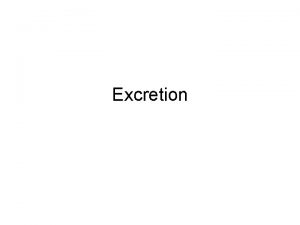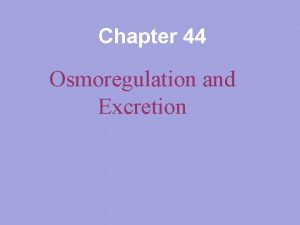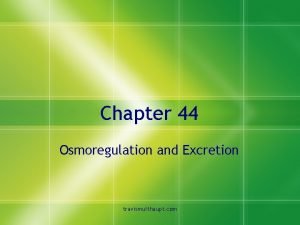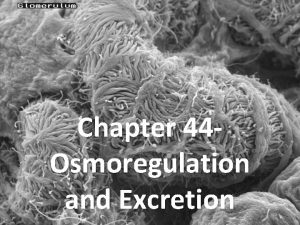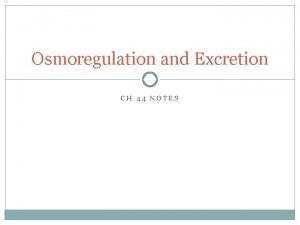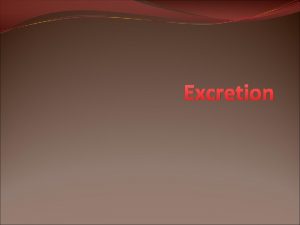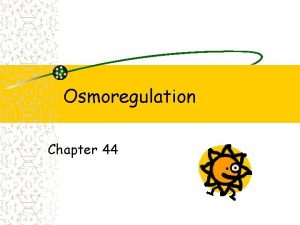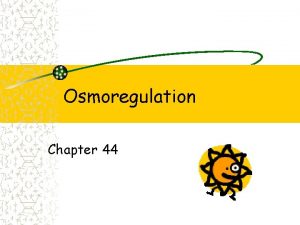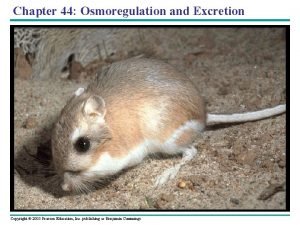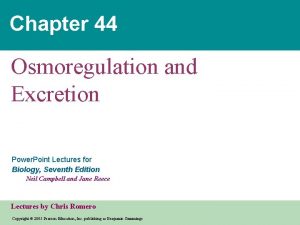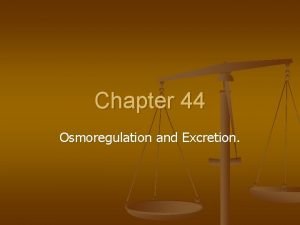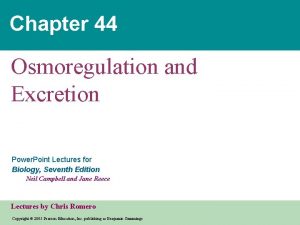Chapter 44 Osmoregulation and Excretion Essential Idea All



























































- Slides: 59

Chapter 44 Osmoregulation and Excretion Essential Idea: All animals excrete nitrogenous waste products and some animals also balance water and solute concentrations.

Osmoregulation & Excretion ±Osmoregulation is the process by which animals regulate solute concentrations and balance the gain and loss of water. ±Excretion is how animals get rid of nitrogen containing waste products.

Some Important Terms ±Isoosmotic -a situation where there is no net flow of water in or out of a cell. ±Hypoosmotic -solutions are more dilute and contain more water. ±Hyperosmotic -solutions have a large concentration of solutes.

Balancing Water Gain and Loss ±There are 2 basic solutions available to animals for managing water: ± 1. Become an osmoconformer-these animals have no gain or loss of water. They are isotonic with their surroundings, (only available to marine animals). ± 2. Become an osmoregulator-control osmolarity because bodily fluids have a different osmolarity than the surroundings, (terrestrial, fresh water and marine animals).

Osmoregulation ±Osmoregulation requires the expenditure energy to conform to their surroundings. ±Typically, about 5% of resting metabolic energy is used for osmoregulation. ±Some animals use up to 30% in very salty environments.

Osmoregulation ±The ultimate goal of osmoregulation is to maintain the composition of cellular cytoplasm. ±Most animals do this by maintaining and managing the internal body fluid.

Hemolymph & Interstitial Fluid ±Animals with an open circulatory system have a fluid called hemolymph. ±Example: Insects. ±Animals with a closed circulatory system have interstitial fluid. ±Example: Squirrel.

Specialized Epithelium ±Most animals have specialized epithelium that is involved in the transport of fluid and the regulation of solute concentrations. ±These epithelia act to move specific solutes in controlled amounts in specific directions.

Specialized Epithelium ±Impermeable tight junctions join these cells. ±Most animals have these transport epithelia joined into extensive tubular networks. ±These networks have extensive surface areas and are connected to the outside of the body by an opening.

Waste Elimination ±Most of the metabolic wastes produced by an animal get dissolved in water before they are eliminated. ±They also get converted to something less toxic at a metabolic cost. ±Products of nitrogen breakdown are the most important items which need to be eliminated.

Waste Elimination ±NH 3 is the most toxic, and very soluble in water, commonly excreted by fish. ±Ammonia excretion is common to aquatic animals, but not terrestrial animals. ±Birds excrete uric acid. ±As a result of nitrogen metabolism, animals need lots of water.

Waste Elimination ±To get around the toxicity of ammonia and the lack of copious amounts of water, terrestrial animals convert nitrogenous waste products to urea. ±Urea is less toxic than ammonia. ±Less water is needed to move higher concentrations. ±NH 3 + CO 2 --> CO(NH 2)2 (urea)

Waste Elimination ±The circulatory system carries the waste to the kidneys where it is excreted. ±The main disadvantage is that it requires a lot of metabolic energy to convert ammonia to urea.

Waste Elimination ±Some animals create uric acid and excrete the substance in a paste. ±Advantage-not a lot of water is needed. ±Disadvantage-it requires a lot of metabolic energy.

Waste Elimination ±Waste elimination is dependent on evolutionary lineage and habitat. ±Animals living in dry habitats excrete mainly uric acid (birds, reptiles and insects). ±Those living in moist environments excrete mainly urea (mammals). They may also excrete ammonia (fish).

Physiological Adaptations ± There a variety of excretory systems that produce urine and they all involve several steps: ± 1. Body fluid is collected ± 2. Filtration through a selectively permeable membrane. ± 3. Formation of filtrate. ± 4. Selective reabsorption of resources: sugars, amino acids. ± 5. Nonessential solutes are left in the fluid.

Excretory Systems ±Excretory systems are all built using the same basic functions: ±A network of tubules provide a large surface area for the exchange of water, solutes, and wastes.

Arthropoda-insects ± Malpighian tubules are found in insects and other terrestrial arthropods. ± These remove nitrogenous waste and function in osmoregulation. ± They open into the digestive tract and dead end into the hemolymph.

Arthropoda-insects ± The transport epithelium lines the tubules and secretes wastes into the lumen of the tubule and water follows. ± The wastes are passed to the rectum, most solutes and water are taken back up and uric acid is produced.

Vertebrate Kidneys ±Vertebrate kidneys function in osmoregulation and excretion. ±They contain numerous tubules arranged in a highly organized manner. ±A dense network of capillaries is also associated with the ducts and tubules that carry urine out of the kidney-and the body.

Kidney ± The renal artery supplies the kidney with blood; the renal vein drains it. ± The composition of blood in the renal artery is different from that of the renal vein. ± Urine exits the kidney through the ureter. ± These drain to the urinary bladder. ± The urine exits through the urethra. http: //www. ivy-rose. co. uk/Topics/Urinary. System_c. Ivy. Rose. jpg

travismulthaupt. com

Mammalian Kidney ±It is broken into two parts: ± 1. The inner medulla ± 2. The outer cortex ±Both regions are packed with excretory tubules and blood vessels. http: //www. ivy-rose. co. uk/

Mammalian Kidney ± The nephron is the functional unit. ± One end contains a ball of capillaries called the glomerulus. ± The blind end of the tubule is a cup-shaped swelling called Bowman’s capsule which surrounds the glomerulus. http: //courses. washington. edu/hubio 562/diabetic. Nephropathy/normal. Glom. html http: //www. lab. anhb. uwa. edu. au/mb 140/Core. Pages/Urinary/Images/kidneydiagram. jpg

travismulthaupt. com

Mammalian Kidney ±Filtration occurs as blood pressure forces fluid from the blood in the glomerulus into the lumen of Bowman’s capsule. ±The porous capillaries along with podocytes are permeable to water and small solutes. ±Larger molecules cannot pass through. http: //www. liv. ac. uk/~petesmif/teaching/1 bds_mb/notes/kidney/images/prox. gif http: //www. uni-ulm. de/elektronenmikroskopie/GLOMERULUS. jpg

Mammalian Kidney ±The filtrate contains salts, glucose, aa’s, vitamins, nitrogenous wastes. ±After filtration in Bowman’s capsule, the filtrate passes through 3 regions of the nephron: ± 1. The proximal tubules ± 2. The loop of Henle ± 3. The distal tubule http: //www. lab. anhb. uwa. edu. au/mb 140/Core. Pages/Urinary/Images/kidneydiagram. jpg

Mammalian Kidney ± 1. The proximal tubule is the first part of the tubule that leaves Bowman’s capsule. ±The proximal convoluted tubule selectively reabsorbs useful substances by active transport. http: //www. lab. anhb. uwa. edu. au/mb 140/Core. Pages/Urinary/Images/kidneydiagram. jpg

Mammalian Kidney ± 2. The loop of Henle consists of the descending limb, a sharp hairpin turn, and the ascending limb. ±The length of the loop of Henle is positively correlated with the need for water conservation in animals. ±The drier the environment, the longer the loop of Henle. ±Fish have no loop of Henle. http: //www. lab. anhb. uwa. edu. au/mb 140/Core. Pages/Urinary/Images/kidneydiagram. jpg

Mammalian Kidney ± 3. The distal tubule empties into the collecting duct. The collecting duct flows into the renal pelvis and gets drained by the ureter. http: //www. lab. anhb. uwa. edu. au/mb 140/Core. Pages/Urinary/Images/kidneydiagram. jpg

travismulthaupt. com

travismulthaupt. com

travismulthaupt. com

Mammalian Kidney ±There are two main types of nephrons: ± 1. Cortical nephrons ± 80% of the nephrons. Have reduced loops of Henle and are confined to the renal cortex.

Mammalian Kidney ± 2. Juxtamedullary nephrons ±The remaining 20% of nephrons. Have well developed loops of Henle. ±Only mammals and birds have juxtamedullary nephrons. ±These nephrons are important because they enable the production of hyperosmotic urine. ± They are urine concentrating organs. They are key adaptations. They get rid of waste, and not much water.

Mammalian Kidney ± The nephron is lined with transport epithelium that processes filtrate and forms urine. ± The epithelium has an important task: Reabsorption of dissolved solutes and water. http: //www. astrographics. com/Gallery. Prints/Display/GP 2079. jpg

Mammalian Kidney ±About 1100 -2000 L of blood flow through the kidneys each day. ±About 180 L of filtrate is formed, and from this 99%+ of all dissolved sugars, vitamins, organic nutrients, and water are reabsorbed. ±Only about 1. 5 L becomes urine.

Mammalian Kidney ± The afferent arteriole supplies blood to the nephron. ± This branch of the renal artery becomes the capillaries of the glomerulus. ± As the capillaries leave, they become the efferent arteriole. ± The efferent arteriole subdivides and becomes the peritubular capillary that surrounds the proximal and distal tubules. http: //www. anatomy. iupui. edu/courses/histo_D 502/D 502 f 04/lecture. f 04/urinaryf 04/C 44 -21 C. jpg

travismulthaupt. com

Mammalian Kidney ± Capillaries extend downward and form the vasa recta. ± These form a loop and serve the loop of Henle. ± The tubules and capillaries don’t exchange materials directly, they are bathed in interstitial fluid. ± Various substances diffuse through this fluid and the filtrate in the nephron becomes urine. http: //www. anatomy. iupui. edu/courses/histo_D 502/D 502 f 04/lecture. f 04/urinaryf 04/C 44 -21 C. jpg

Mammalian Kidney--The Proximal Tubule ± The proximal tubule cells maintain a constant p. H within the lumen, they actively control secretion of H+. ± They reabsorb about 90% of HCO 3 - to maintain the p. H of body fluids. ± Drugs and other poisons pass from the peritubular capillary, into the interstitial fluid, across the epithelium of the proximal tubule and into the lumen of the nephron. http: //www. anatomy. iupui. edu/courses/histo_D 502/D 502 f 04/lecture. f 04/urinaryf 04/C 44 -21 C. jpg

Mammalian Kidney--The Proximal Tubule ± In contrast, the useful nutrients pass from the lumen of the proximal tubule across the transport epithelium into the interstitial fluid and to the peritubular capillaries. ± One of the most important functions is the reabsorption of Na. Cl and H 2 O. http: //www. anatomy. iupui. edu/courses/histo_D 502/D 502 f 04/lecture. f 04/urinaryf 04/C 44 -21 C. jpg

Mammalian Kidney--The Proximal Tubule ± Sodium diffuses into the transport epithelium. ± It is actively pumped into the interstitial fluid. ± Cl- follows passively to balance charge. ± H 2 O follows by osmosis. ± Na. Cl and H 2 O now diffuse into the peritubular capillary. http: //www. anatomy. iupui. edu/courses/histo_D 502/D 502 f 04/lecture. f 04/urinaryf 04/C 44 -21 C. jpg

Mammalian Kidney--The Descending Loop of Henle ± The descending loop is freely permeable to water. ± It is not permeable to Na. Cl. ± The interstitial fluid becomes progressively more concentrated (hypertonic) as you go from the cortex to the medulla, and water flows out of the loop. http: //www. anatomy. iupui. edu/courses/histo_D 502/D 502 f 04/lecture. f 04/urinaryf 04/C 44 -21 C. jpg

travismulthaupt. com

Mammalian Kidney--The Ascending Loop of Henle ± Moving up the loop, the transport epithelium is now permeable to Na. Cl and not H 2 O. ± There are 2 regions of the ascending limb: ± 1. A thin region--Na. Cl diffuses out and into the interstitial fluid. ± 2. A thick region--Na. Cl is actively pumped out of the tubule and into the interstitial fluid. http: //www. anatomy. iupui. edu/courses/histo_D 502/D 502 f 04/lecture. f 04/urinaryf 04/C 44 -21 C. jpg

Mammalian Kidney--The Ascending Loop of Henle ±These mechanisms increase the osmolarity of the interstitial fluid and create a more dilute filtrate. ±In this way, the loop of Henle maintains hypertonic conditions in the medulla to produce urine.

Mammalian Kidney--The Distal Tubule ± The distal tubule regulates the p. H like the proximal tubule. ± It also regulates the amount of K+ and Na. Cl concentrations of body fluids by varying the amount of K+ secreted and Na. Cl absorbed from the filtrate. http: //www. anatomy. iupui. edu/courses/histo_D 502/D 502 f 04/lecture. f 04/urinaryf 04/C 44 -21 C. jpg

Mammalian Kidney--The Collecting Duct ± It actively reabsorbs Na. Cl. ± The degree of permeability of Na. Cl is under hormonal control. ± The epithelium is permeable to water and not to salt. ± As the collecting duct traverses the gradient of osmolarity in the kidney, the filtrate becomes increasingly more concentrated.

Mammalian Kidney--The Collecting Duct ± It is permeable to urea in the medulla (not the cortex). ± Some urea diffuses out of the duct and into the interstitial fluid increasing the osmolarity. ± The high osmolarity of the kidney enables it to conserve water by creating urine hyperosmotic to the general body fluids. ± Provides a good example of structure-function relationship.

Mammalian Kidney ±It is a versatile organ. ±It is under nervous and hormonal control. ±This is how it regulates the amount of urine produced and its concentration.

Mammalian Kidney--Hormones ±ADH is a water regulating hormone. ±It is produced in the hypothalamus. ±It is stored and released by the pituitary.

Mammalian Kidney--Hormones ±The hypothalamus has osmoreceptor cells. Their set point is 300 mosm/L ±When the osmolarity of blood goes above this, ADH is released and acts on the distal tubules and collecting ducts. ±The hormone increases the permeability of the cells of the tubes. ±Water reabsorption is increased and the concentration of the urine increases.

Mammalian Kidney--Hormones ±As more water gets reabsorbed, ADH release slows and the osmolarity goes down. ±A negative feedback example.

Mammalian Kidney--Hormones ± When a lot of water is consumed, little ADH is released. ± Water reabsorption is slowed and a large volume of urine is produced.

Mammalian Kidney--RAAS Hormones ± There is a second regulatory mechanism involving the JGA. ± It is near the afferent arteriole which supplies the blood to the glomerulus.

Mammalian Kidney--RAAS Hormones ±When blood pressure decreases, an enzyme called renin initiates a chemical reaction. ±Angiotensinogen in the blood is converted into angiotensin II. ±Angiotensin II increases the blood pressure by constricting the arterioles. ±This decreases blood flow to the capillaries.

Mammalian Kidney--RAAS Hormones ±Angiotensin II also stimulates the proximal tubules to absorb more H 2 O and Na. Cl. ±This decreases the amount of salt and water in the urine increasing the blood volume and blood pressure.

Mammalian Kidney--RAAS Hormones ±Angiotensin II stimulates the adrenal glands to release aldosterone. ±Aldosterone acts on the nephron’s distal tubules causing them to reabsorb more sodium and water. ±This also increases blood volume and blood pressure.
 Tonicity and osmoregulation
Tonicity and osmoregulation Osmoregulation
Osmoregulation Protonephridia
Protonephridia Osmoregulation
Osmoregulation Renal artery branches
Renal artery branches Osmoregulation in invertebrates
Osmoregulation in invertebrates Osmoregulators vs osmoconformers
Osmoregulators vs osmoconformers Osmoregulation
Osmoregulation Blobfish homeostasis
Blobfish homeostasis Chapter 37 respiration circulation and excretion
Chapter 37 respiration circulation and excretion Plamatic acid
Plamatic acid What is the function of glomerulus class 10
What is the function of glomerulus class 10 Respiration and excretion
Respiration and excretion Cardiac sphincter
Cardiac sphincter Digestion and excretion lesson 3
Digestion and excretion lesson 3 Name a line containing point a
Name a line containing point a Whats central idea mean
Whats central idea mean Control idea
Control idea What is the difference between topic and theme
What is the difference between topic and theme Supporting sentence and concluding sentence
Supporting sentence and concluding sentence Stated main idea and implied main idea
Stated main idea and implied main idea Essential idea
Essential idea What is excretion
What is excretion Ion trapping
Ion trapping Water soluble vitamins
Water soluble vitamins What is excretion
What is excretion What is excretion
What is excretion Fractional excretion of sodium
Fractional excretion of sodium Process of excretion
Process of excretion Nicotine excretion
Nicotine excretion What is excretion
What is excretion Vitamin d for body
Vitamin d for body Metabolic waste
Metabolic waste Seeds travel
Seeds travel Sponges characteristics
Sponges characteristics Malpighian tubules
Malpighian tubules Plant hormone
Plant hormone Hagfish excretory system
Hagfish excretory system Excretion
Excretion Excretion
Excretion Excretion
Excretion Drug excretion
Drug excretion Urine
Urine Fractional excretion of sodium
Fractional excretion of sodium Diasylate
Diasylate Qqbreak
Qqbreak Metabolic waste
Metabolic waste Porifera excretion
Porifera excretion Porifera excretion
Porifera excretion Homiletical idea
Homiletical idea Contoh penanda kronologi
Contoh penanda kronologi She's all states and all princes i nothing else is
She's all states and all princes i nothing else is Chapter 4 creativity and the business idea
Chapter 4 creativity and the business idea Barriers to creativity
Barriers to creativity Mendel and the gene idea chapter 14
Mendel and the gene idea chapter 14 Chapter 14 mendel and the gene idea
Chapter 14 mendel and the gene idea Chapter 14 mendel and the gene idea
Chapter 14 mendel and the gene idea Chapter 14: mendel and the gene idea
Chapter 14: mendel and the gene idea Chapter 14 mendel and the gene idea
Chapter 14 mendel and the gene idea Chapter 14 mendel and the gene idea
Chapter 14 mendel and the gene idea

